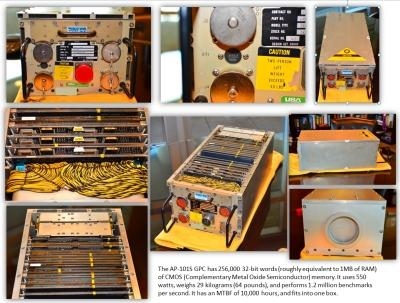Will Be Used By Students To Study Survival Systems
Some parts of NASA's shuttle program are finding some new life in academia. Nova Southeastern University's (NSU) Graduate School of Computer and Information Sciences in Fort Lauderdale, FL, has received one of the NASA Space Shuttle's on-board general purpose computers (AP-101S GPC). Faculty and students will study the design and construction of survival systems using the shuttle's computer.

NSU was selected to receive the computer due in part to the university's science, technology, engineering, and mathematics (STEM) programs and the Buehler center that will focus on Space-based research. The donation is estimated at approximately $1.2 million. The computer will also be part of an exhibit in 2013 showcased initially at NSU's Alvin Sherman Library, Research, and Information Technology Center, and then afterward at the Emil Buehler Research Center for Engineering, Science and Mathematics. The exhibit will highlight how computers work side-by-side with man to explore our universe.
"The computer we received most likely flew aboard Space Shuttles Columbia, Discovery, Atlantis, and Endeavour. It is very exciting to have such an important piece of space history at NSU for use by faculty and students to conduct research and inspire young minds," said Eric S. Ackerman, Ph.D., interim dean of the Graduate School of Computer and Information Sciences.
The computer NSU received was built in 1992 and ran for over 6,000 hours. NSU hopes to inspire young minds to explore STEM careers and bring awareness to the degree programs NSU offers in these areas. The process of obtaining the computer was initiated in 2009 and involved multiple personnel at NASA and NSU. The space shuttle avionics system consists of more than 300 major electronic black boxes located throughout the vehicle, connected by more than 300 miles of electrical wiring. There are approximately 120,400 wire segments and 6,491 connectors in the vehicle. The wiring and connectors weigh approximately 7,000 pounds, with the wiring alone weighing approximately 4,600 pounds. The total weight of the black boxes, wiring and connectors is approximately 17,116 pounds. The black boxes are connected to a set of five general-purpose computers through common party lines called data buses. The black boxes offer dual or triple redundancy for every function.
The space shuttle used five AP-101s as "general-purpose computers" (GPCs). Four operate in sync, for redundancy, while the fifth served as a backup running software written independently. The shuttle software was written in HAL/S, a special-purpose high-level language. The AP-101S GPC has 256,000 32-bit words (roughly equivalent to 1MB of RAM) of CMOS (Complementary Metal Oxide Semiconductor) memory. It uses 550 watts, weighs 64 pounds, and performs 1.2 million benchmarks per second. It has an MTBF of 10,000 hours, and fits into one box.
The computers controlled the shuttle from T-20 minutes in the countdown through orbit insertion sequence. All five computers had to be in sync and working properly; otherwise, the launch was scrubbed. When the shuttle arrived in space, the crew re-configured the computers for orbital operations. Two GPCs run the on-orbit program, and one GPC is dedicated to payload operations. One GPC is powered down but has the landing program loaded in case an emergency requires the crew to return in a hurry. The final GPC is powered down until needed.
If one GPC failed in orbit (or even two) the mission wouldn't necessarily have to be aborted if the problem wasn't expected to affect the other GPCs. In theory, any of the five computers had the capability to land the shuttle safely. During reentry and landing, all five GPCs operated together again.
(Image provided by NSU)
 NTSB Final Report: Rutan Long-EZ
NTSB Final Report: Rutan Long-EZ ANN FAQ: Turn On Post Notifications
ANN FAQ: Turn On Post Notifications Classic Aero-TV: ICAS Perspectives - Advice for New Air Show Performers
Classic Aero-TV: ICAS Perspectives - Advice for New Air Show Performers ANN's Daily Aero-Linx (06.28.25)
ANN's Daily Aero-Linx (06.28.25) Aero-News: Quote of the Day (06.28.25)
Aero-News: Quote of the Day (06.28.25)



